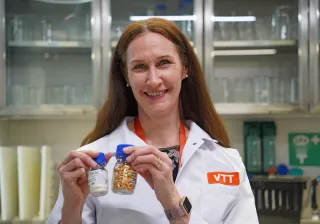Cellular agriculture is a rapidly developing and promising food production method. It can accelerate building a sustainable and profitable food system in Finland and the whole Europe. VTT Technical Research Center of Finland, Natural Resources Institute Finland and University of Helsinki have investigated the current state of cellular agriculture and listed eight recommendations for policymakers at the request of the Ministry of Agriculture and Forestry and Business Finland. The most urgent measures include investments in production-scale infrastructures and expediting and streamlining EU’s regulatory process.
Read the summary
- Cellular agriculture in Finland presents substantial growth opportunities, with cell factories playing a critical role in producing essential food ingredients while advancing sustainability and resilience against climate change, presents the new report by VTT Technical Research Center of Finland, Natural Resources Institute Finland and University of Helsinki.
- Finland is strategically positioned to become a leader in cellular agriculture, leveraging its abundant natural resources and expertise in industrial biotechnology.
- The report outlines eight strategic measures to advance cellular agriculture in Finland, including infrastructure investments, regulatory adjustments at the EU level, and a dedicated RDI programme, which are essential for accelerating the sector's development and export potential.
- Challenges such as limited capital access and complex regulatory procedures need addressing to enable growth and attract international investment, with government support crucial for overcoming these obstacles and boosting Finland’s competitive edge in global markets.
This summary is written by AI and checked by a human.
Cellular agriculture involves the use of cell cultures, such as microbial, algae, plant, insect, or animal cells, and bioreactors for food production. Cell factories produce various ingredients, such as proteins and fats, for the food and feed industries. Additionally, cell cultures can produce ingredients for products like coffee and cocoa, whose traditional cultivation is becoming challenging due to climate change.
"The future food system will be based on the interplay between modern agriculture and cellular agriculture, utilizing circular economy solutions. This development brings many new business opportunities for Finland and the food system actors. We must identify the necessary change paths and ensure that measures consider the entire chain, from farmers to consumers and other stakeholders," says State Secretary Päivi Nerg from the Ministry of Agriculture and Forestry.
Cellular agriculture is a strategically important sector that, in addition to economic growth, increases food self-sufficiency, resilience, and strategic autonomy of individual countries like Finland, but also the EU. The market volume forecast is promising, and the report estimates the export potential for Finland to be €500-1000 million by 2035. In addition, significant infrastructure investments open opportunities for billions in exports of equipment, technology, and expertise.
Achieving success requires significant investments and regulatory changes
To turn the vision of a new food system into reality and exports, companies and investors need the courage to seize the market shift. The government also needs to take action, including supporting investments and measures to increase international companies' interest in investing in Finland.
"One of Finland's biggest challenges currently is the lack of capital, which limits the growth opportunities of cellular agriculture. Building production facilities requires large investments, and success will not come without government support to accelerate investments and realize venture capital investments," says Emilia Nordlund from VTT, who led the study.
The report also proposes launching a five-year, €100 million research, development, and innovation program to accelerate the sector in Finland. Additionally, it is critical to ease the market entry of novel foods to allow the sector to grow. The current EU regulations and approval processes slow down the development of cellular agriculture and drive companies to the United States and Asia. This issue calls for action at the EU level.
Feedstocks, energy infrastructure, and top experts are Finland's competitive advantages
There is plenty of carbohydrate-rich side streams, such as straw, sawdust, wood chips, and grass biomass in Finland, which could be utilized as feedstocks for cellular agriculture. For example, if more than half of the straw were used as a sugar source for cell factories, the produced microbial protein would be enough to meet the annual protein needs of Finns.
"Top-level expertise in industrial biotechnology combined with the processing knowledge of agricultural and forestry biomass and renewable energy infrastructure can offer Finland a competitive edge. As a small and agile country, we can collaborate smoothly and create innovations that integrate cell factories seamlessly into the food production system," summarizes Emilia Nordlund.
"Compared internationally, Finland is at the forefront of development, but now it is important to take action and realize the predicted growth opportunities for the sector. Finnish companies should recognize their strengths as part of emerging new value networks and build their competitiveness in the long term together with research organizations. Business Finland is already currently funding ambitious cellular agriculture RDI projects, so there is no need to wait for a separate program," says Executive Director Teija Lahti-Nuuttila from Business Finland.
8 steps to promote cellular agriculture in Finland
- Accelerate investments in infrastructure: Finland needs an action plan to increase venture capital investments and international companies' interest in investing in Finland. Investing in infrastructure is essential to enable new value chains, and the government must create risk financing and loan instruments to enable factory investments.
- Expedite EU-level regulatory processes: Current regulations slow down the sector's development. Establish an office in Finland that provides concrete support for the novel food process in cellular agriculture: both financial assistance and advice. The office would also actively influence the EU to expedite, support, and ease the adoption of new technologies.
- Launch an RDI program: A five-year, €100 million research, development, and innovation program would produce innovations for the future food system, combining traditional agriculture and cellular agriculture. The program aims to create sustainable solutions that leverage Finland's strengths, such as technological expertise and abundant natural resources.
- Establish a Ministry of Future Food: A joint working group or organization of ministries would develop the future food system. The organization would also support the RDI program and promote cross-sectoral collaboration.
- Secure future experts for the sector: The knowledge base must be expanded, and education programs developed to meet the growing demands of the sector. Education should produce experts and expertise for the food sector broadly, including cellular agriculture and circular economy.
- Support consumer communication and enable public tastings: Communicating inspiringly about cellular agriculture innovations and allowing public tasting events increases consumer awareness of the future and familiarity with new products. Consumer participation in co-development should be enabled. Expert-organized tastings of novel foods should be allowed in Finland.
- Integrate primary production into cellular agriculture value chains: The production and quality standardization of feedstocks for cellular agriculture processes are critical in the new value chains, and it also opens new business opportunities for primary producers. Incentives must be created to enhance collaboration with primary producers.
- Target support functions for exports: When assessing the growth and export potential of cellular agriculture, both domestic production and related product exports, as well as equipment, technology, expertise exports, and IP licensing, must be considered. Building factories and value chains abroad should not be forgotten. Support functions should target all aspects of exports and understand the development prospects of different export markets.
The study was conducted by mapping the current state of cellular agriculture and the development of the operating environment in Finland and international markets. Additionally, expert knowledge was gathered through stakeholder interviews and vision workshops.
Explore the summary of the report 'Sustainable growth from cellular agriculture value chains - Action plan for Finland' and download it here.






